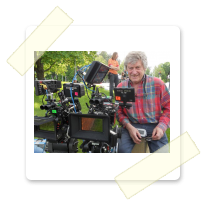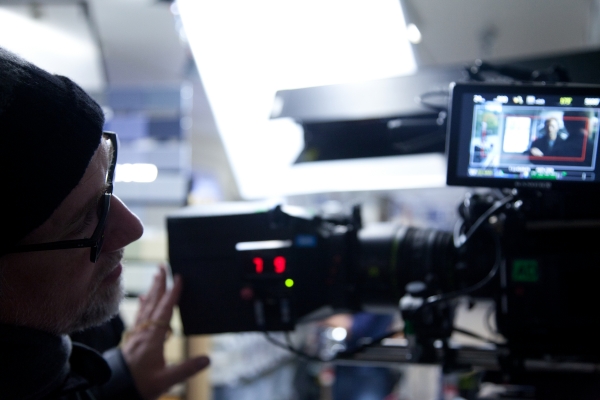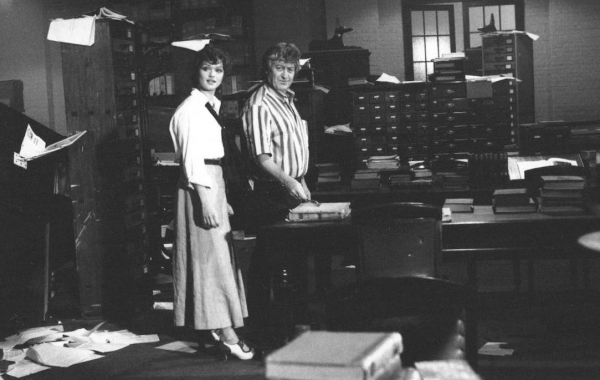Q & A with David Worley, Camera Operator

David Worley is a Camera Operator with over 50 major feature film credits on his CV. He has won two GBCT awards for Best Operator and is a founder member of the Association of Camera Operators and Associate of the BSC.
He has worked with Directors such as Steven Spielberg, James Cameron, Ridley Scott & David Fincher and his credits include the Indiana Jones Trilogy, Aliens, James Bond, Harry Potter, The Mummy, The Full Monty and most recently, Game of Thrones and The Girl with the Dragon Tattoo....
For those who haven’t seen The Girl With the Dragon Tattoo, can you tell us about the story and how you approached it.
“The Girl with the Dragon Tattoo”, the book by Stieg Larsson, had already been made into a film in Sweden. It’s about a journalist who, having just lost a court case against a international industrialist, is initially approached to write a biography of a rich businessman but the real reason he is being engaged is to find out what happened to this man’s niece who disappeared – presumed murdered – nearly forty years previously. He is assisted by a girl who is a computer hacker and has had a very unstable upbringing and this unlikely partnership of two vulnerable people becomes a search for a mass murderer of women.

David Fincher is renowned for his visual style, how did you find working on set with his meticulous approach?
David Fincher was thought to be the ideal candidate to direct the US version of this story, to put his stamp on what was an already highly successful phenomenon.
I had worked with David before – six months in Pinewood Studios on “Alien 3” – so I was more than aware of his precise style and meticulous way of shooting. We started in Sweden in September 2010 until the end of November when we moved to Zurich for a week. In January, interior shooting started at Paramount Studios in LA for 10 weeks and I was involved for a good two-thirds of that. Then there were four days in London at the end of March and finally back to Sweden for about 10 more weeks from April to June – about 160 days shooting in all.
We used RED One cameras and Arri Master Prime lenses for most of the film until the RED Epic cameras became available. David Fincher rarely uses a viewfinder on set as he appreciates what each lens will give him – I would line shots up and he would finesse via the on-set monitors. He is extremely precise in regards to this so I knew the exact framing he was aiming for prior to shooting. It’s well known that he likes to do many takes, whether for technical or non-technical reasons. Fincher is a perfectionist and expects – and gets – the highest standards of expertise from all the participants on set.
Going back to the start of your career, when did you first become interested in cinema and how did you get into the industry.
I think I always wanted to be involved with films from when I saw Laurel and Hardy on television when I was quite small but I started as a trainee with British Transport Films when documentaries were made in 35mm on wild cameras and the sound would be dubbed later! Then I became a freelance clapper –loader , followed by 10 years as a focus puller before my first operating assignment on the 2nd. unit of “Raiders of the Lost Ark”.
Your first major job was on the Indiana Jones series. There were some legendary set pieces in those films and almost all in-camera action. What was it like to work on those films?
Working on the Indiana Jones films was quite an experience. The shooting days were not particularly long but what hours there were pretty action-packed. Steven Spielberg had boundless energy, always seemed to know what he wanted and how to get it so the pace fairly rattled along. You knew you were in the presence of a great film maker – I learned a lot through working on those films!
Who Framed Roger Rabbit pushed the barriers of technology when it was released in 1988. Can you describe how you captured the movements of non-existent characters?
“Who Framed Roger Rabbit” was very innovative at the time of shooting and still stands up well today. Although the cartoon characters were obviously drawn, the props around them – and even anything that they had in their hands - were real. I particularly remember the Ink and Paint cub that we shot in Elstree Studios where the penguin waiters were all supposed to be dashing about with trays of drinks – all you saw were the trays on sticks moving round the set, being manipulated from underneath, and knowing that the sticks would be covered over by the penguins’ legs in the finished film. And, on the last day of shooting, I operated the crane shot when the movie goes from total animation to reality with Joel Silver, the legendary producer, playing the director! Although that movie was obviously beset with all sorts of problems and challenges, I don’t remember the director, Robert Zemeckis, raising his voice once.
With The World is Not Enough and Quantum of Solace, you’ve worked with both Pierce Brosnan and Daniel Craig as Bond. We’ll resist the obvious question, but can you tell us a little about what it’s like to work on the iconic series?
Bond films are different again. I was on the main unit of “The World is not Enough” and, although we filmed all the dialogue scenes we were able to get involved in some of the action sequences when they involved Pierce Brosnan and any other leading artiste. But at one point there were four other units – second, action, model and plate units – and all this material has to be collated and co-ordinated to achieve the finished product. But the producers always manage to bring it off with style – that’s why they’re currently making their 23rd. Bond movie!
Camera technology has changed immeasurably since your first film, how have you had to adapt your technique?
Technology has changed the way we do certain things but the basic job of camera operating has really changed very little. Crane shots are invariably operated remotely these days which means that the cranes themselves can be much lighter and so more easily transported – but if I’m on a ride-on crane, I feel so much more part of the action and have more control. And you can then look through the camera and not at a monitor!
What do you consider is the most important aspect in operating and how can it effect the overall look of the film.
There are many facets to camera operating but one of the most important things to remember is that, although you are a key member of the crew, you are also part of a team. Teamwork is the essence of successful film making and, as an operator, you are right in the middle of it all so you must be a good communicator.
 What has been your favourite experience on a film set?
What has been your favourite experience on a film set?
There is one particular shot from “The Mummy” – photographed by Adrian Biddle with whom I must have collaborated on 14 or 15 films – that is a favourite of mine. It’s in a circular library set with large free-standing shelf units and starts off with a stunt double for Rachel Weisz out of control on a ladder and the camera is bang in the middle of the set. The ladder hits the first shelf which, in turn, hits the second one until all the shelves and all the books have fallen over - and the camera pans round with them – and the real Rachel rises into shot finally and says, “Oops!” What was really satisfying that we did it in one take – there couldn’t really be a rehearsal for that!
If you could change one thing about the UK film industry, what would you do?
Virtually all the medium to big budget films made in the UK are US funded – it would be great to work on a film in this country with a reasonably – sized budget with some A-list talent that had been totally financed from here AND was an international hit!
What have you been working on most recently?
The most recent production that I’ve been involved with is the second season of “Game of Thrones” for HBO – two permanent crews working with several directors and directors of photography over four or five months to produce ten episodes! It sounds quite chaotic – and sometimes it was – but I have to say that the end result is very pleasing.
David Worley is a member of thecallsheet.co.uk and is represented by Exec Management. To see David's full profile, please click here
With thanks to David and Pic Select for the above images.
Find out more about thecallsheet.co.uk